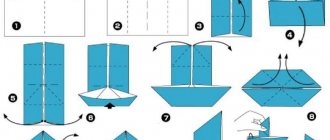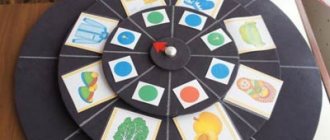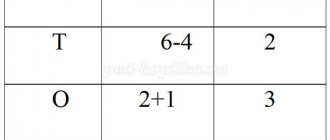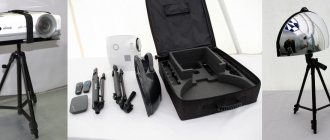Interactive educational center "Eureka"
Experience in operating an interactive learning center based in a preschool educational institution
The Federal State Educational Standard for preschool education places special emphasis on the conditions for the implementation of the educational program. This is how it differs from “school” standards: the fact is that the specifics of preschool childhood (flexibility, plasticity of the child’s development, a high range of options for its development, its spontaneity and involuntariness) make it unlawful to demand specific educational achievements from a preschool child. This means that an adult must, first of all, think about creating conditions for the child’s development. These conditions include, first of all, the nature of the interaction between the child and the adult, as well as the educational environment.
The requirements for the subject-spatial environment formulated in the Federal State Educational Standard are aimed at supporting children's initiative in all types of children's activities. The organization of the educational space and the variety of materials, equipment and supplies should ensure:
— gaming, cognitive, research and creative activity of pupils;
— motor activity, incl. development of gross and fine motor skills;
— emotional well-being of children in interaction with the subject-spatial environment;
- the opportunity for preschoolers to express themselves.
To implement these tasks, the subject-spatial environment must be content-rich, transformable, variable, multifunctional, accessible and safe.
The Interactive Cognitive Center (IOC) created at the preschool educational institution is an innovative experience in creating a special space, the structural organization and unique equipment of which allows for the implementation of a qualitatively new approach to the development of the personality, motivation and abilities of children.
The center is a single space consisting of thematic (according to areas of activity) structural units - mini-centers. This placement allows for the simultaneous work of several children's subgroups, and also allows children to move freely and change activities.
Structure of the interactive and educational center:
The interactive and educational center is located within several rooms, dividing them into sectors (mini-centers):
1. Center for Communication and Linguistics (for children 5-10 years old).
The center is equipped with: a mobile language laboratory, an interactive whiteboard, laptops, a color printer, etc.
The center organizes the following activities:
— familiarization with computer graphics, graphic design, creation of presentations (slides);
— methods of immersion in the language environment, listening, online communication in a foreign language;
— children's printing house (typesetting, digital printing, binding);
— children's video studio (animation for preschoolers).
The language lab was created to introduce students to foreign speech during their early learning of the English language. The specialized office is equipped with a complex of sound and projection equipment, which allows the audiovisual method to create optimal conditions for students’ independent work in mastering the skills of oral non-native speech.
Equipment for the language laboratory allows the teacher:
— organize and control the independent work of each student with individual educational material;
— include simultaneously several training programs for certain training groups;
- record and reproduce the speech of pupils;
- comment on sound recordings.
The teacher’s use of a language laboratory allows him to plan a lesson in such a way that each student learns the subject in accordance with his or her individual characteristics.
Another advantage of using a language laboratory is the presence of several types of modes: paired, group, individual work, random selection mode. The program allows the teacher to connect at any time, controlling the progress of the lesson, to any of the students, as well as to those who work in pairs or groups.
2. Center for exciting science “Eureka” (for children 5-10 years old).
The center is equipped with interactive exhibits: “Plasma Ball”, “Dancing Pendulum”, “Static Electricity”, “Mirage”, “Anamorphosis” curved mirrors, “Levitation” globe in a magnetic field, “Mirror Book”, “Tactile Labyrinth”, etc. Educational games: “Balance the balls”, “Carry the load”, “Magnetic pyramids”, “Formido”. Sets: “First steps into electronics”, “Kaleido”, etc.
The following types of activities are organized at the center: familiarization in practical experimental activities with the basics of physical, mathematical, chemical and biological phenomena (optics, mechanics, magnetism, ultrasound, electricity, etc.)
Interactive exhibits are exhibits that allow children to independently explore the laws of physics, chemistry, and mathematics. Unlike the usual museum exhibits, which can only be viewed, these exhibits are created so that children can conduct scientific experiments with their own hands and obtain visual, spectacular, and often unexpected results. The selection of exhibits was made in such a way that the phenomena shown were visual and understandable for children and did not require preliminary preparation and consultation of teachers. A description of the essence of the phenomena and the experimental technique is located next to each exhibit on a special stand.
An interactive educational environment makes it possible to study the laws of the Universe in a playful way, to interest children in new areas of knowledge, and to organize interesting and educational leisure time.
3. Research center-laboratory (for children 5-10 years old).
The center is equipped with: a digital laboratory “Naurasha”, a digital microscope, a set “Young Physicist”, “Young Chemist”, a Super Pro microscope (we study the microworld), a vegetative system “Green Ball”, a set “Lunar Greenhouse” (plantarium), etc.
The center organizes activities for the formation of natural science concepts, experimental work on the study of physical and biological objects.
The latest equipment is a digital laboratory for preschoolers and primary schoolchildren “Naurasha”. The digital laboratory helps the teacher explain natural properties and phenomena to children in a playful way. The laboratory consists of seven mini-games, each of which is dedicated to its own phenomenon (temperature, light, sound, electricity, magnetic field, force, acidity, pulse). At the heart of each game is a digital sensor that both helps children explore a phenomenon and engages them in the world of experimental science and precision measurement.
4. Art workshop “Light and Color” (for children 3-10 years old).
The center is equipped with: a light and sound interactive panel “Magic Light”, a set “Light and Color”, a transparent easel, a sand table with illumination, a “Rainbow” projector, a Kaleido play set, etc.
The center is equipped with a sand table, a Mirror Drawing instrument table, a set of translucent building cubes, a Kaleido game, etc.
The center organizes:
— studying the nature of light, forming ideas about the color diversity of the surrounding world;
- experiments on mixing colors of the spectrum, obtaining new colors, symmetry in drawing, visual illusions,
— development of artistic design.
The interactive and sound-and-light panel “Magic Light” is used for drawing and creating texts. Modes and colors are controlled using the built-in button on the side of the panel or remote control. Having set the desired mode from a great variety, the text or picture will blink, shimmer or smoothly change colors and shades. With the help of multi-colored sticks (included), children can independently decide what color of the picture or text will be visible on the panel.
Exciting, educational game; the development of creative abilities, activation of cognitive activity, tactile sensations, motor skills, vision, memory are guaranteed.
5. (for children 5-10 years old).
The center is equipped with a weather platform, a “Star World” set (models of planets, a telescope), and a digital planetarium.
The center organizes the following activities:
— observation and experimentation with natural objects;
— observation of astronomical objects, acquaintance with space and the solar system.
Digital planetarium projects the starry sky onto the walls and ceiling of the room. In a big city, it is impossible to enjoy the beauty of space due to illumination from advertising lights and street lights. Many people living in the city have no idea what our galaxy, the Milky Way, looks like. The Mini Planetarium projector displays stars and constellations, as well as the brightest objects of deep space, it serves as an excellent visual aid in astronomy for children and adults, and has a remote control that allows you to change the speed and direction of rotation, as well as the brightness of starry sky objects.
6. Center for early vocational guidance (for children 3-10 years old).
Center equipment: a working model of a railway measuring 2m x 1.8m, a gaming table Railway (mobile gaming table), Robotics sets, LEGO product sets (railway structures), HUNA robotics construction sets FUN&BOTS.
The center organizes the following activities:
— acquaintance with professions;
— technical modeling and design, robotics, construction site.
Various robot models are assembled
Robotics kits are made of bright, strong and safe ABC plastic and are equipped with infrared sensors. The products consist of high-quality and safe plastic. Imitation of sounds, recognition of cliff edges, following a line, avoiding obstacles.
The attached brochure provides step-by-step diagrams for assembling models with an engine (sequentially), you can assemble a “Crocodile Robot”, “Frog Robot”, “Dog Robot”, “Rabbit Robot”. Once assembled, the models move in a straight line thanks to a motor powered by 4 AAA batteries.
7. Center for sensory-graphomotor development (for children 2-5 years old).
The center is equipped with: educational and methodological aids according to the Montessori system, wall tactile and developmental panels.
The center organizes classes aimed at:
- activation of sensory development, development of tactile perception of fingertips, visual control of tactile perception;
- ability to work according to an algorithm, skills of sorting objects according to a pattern;
- development of the wrist and preparation of the hand and eyes for writing.
8.Sensory relaxation room (for children 2-10 years old).
Center equipment: relaxation fountain, children's mirror corner with a bubble column, a bundle of fiber-optic fibers with side glow “Star Rain”, aroma set, fiber-optic tunnel.
The center provides a healing effect on the child: relaxing and activating, corrective and developing therapeutic and educational areas.
The sensory relaxation room is used for the harmonious development of the sensory sphere. Promotes the development of motor, cognitive and communication functions, strengthens the nervous system, and acts as an effective means of maintaining physical health.
9. (for children 2-10 years old).
The center is equipped with: an interactive floor, a digital piano, sets of children's musical instruments, puppet theaters, video and audio equipment.
The center works with children to develop visual and sound perception and coordination of movements.
Interactive flooring represents an effective way to develop children. The multi-touch technologies used allow several people to study and play one educational game at the same time.
A high-quality image has a positive effect on the child’s psyche:
- promotes the child’s adaptation to new conditions;
- allows you to explore the world in a playful way.
Regardless of the time of year and climatic conditions, children can find themselves on a football field, on the ocean shore. They dream, fantasize, and the interactive floor for children is a kind of incentive to visit an educational institution. In our kindergarten, with the help of an interactive floor, unforgettable holiday events are organized that remain in the memory of children and adults for a long time.
10.Motor activity center (for children 2-10 years old).
The center is equipped with: children's exercise equipment (treadmill, exercise bike, stepper, etc.), a climbing wall, step platforms, a transforming wheel, fitballs, a dry pool, hand and foot labyrinths, etc.
The center organizes work with children on:
— development of physical strength, endurance, coordination, agility;
— simulation of the activity of the vestibular apparatus and the development of proprioception skills.
The center combines three important concepts: science, creativity and independent activity of the child, which determines his successful socialization as an individual in society and future professional activity. The IPC equipment allows you to organize work with children of different age categories (from 2 to 10 years old), who have different interests and inclinations and individual development abilities (including gifted preschoolers and children with disabilities).
Forms of organizing the activities of the IPC:
— organization of cognitive and playful activities of pupils in the daily routine (in direct educational activities, in joint activities of the teacher and the child, in independent activities);
— organization of additional education for pupils of NDOU;
— organizing work with parents, including in the form of a parent-child club.
— work with society: interaction with preschool educational institutions and city schools, institutions of additional education
In the modern world, the ability to think independently, relying on knowledge and experience, is valued much higher than just erudition, possession of a large amount of knowledge without the ability to apply this knowledge to solve life problems. Therefore, when working in the IPC, we do not impose our decisions on children; we support their initiative, the desire to express unusual guesses, to do something in their own way.
Educational activities at the Center are of a personal developmental nature of interaction, cooperation between children and adults, recognition of the child as a full participant (subject) of educational relations, built on the basis of the child’s independence and activity in choosing the content of his education, supporting children’s initiative in various types of activities. Teachers implement a system-activity approach to teaching, which is expressed in the fact that the child does not receive knowledge in a ready-made form, but by obtaining it himself, through experimentation, modeling, and solving problematic problems.
The implementation of the activity principle is based on methods (active, interactive, research, design) and technologies (master classes, workshops, projects, trainings, creative and research tasks, problem situations, educational games, interactive excursions). In classes, children work in accordance with their capabilities, participate in equal dialogue, and realize the value of their participation in solving various problems. This technology requires students to be able to express their opinion, justify it, and build a chain of logical reasoning. The educational process is more effective when the teacher speaks less than his students.
The technology of the activity method means that the formulation of an educational problem and the search for its solution are carried out by students in the course of a dialogue specially built by the teacher. Children, under the guidance of a teacher, but with a high degree of independence, answer questions and discover new knowledge.
We give children the opportunity to develop the ability to see every phenomenon from different points of view. Possession of such a skill is one of the most important characteristics of a modern person. It is associated with such personality traits as tolerance for other people's opinions and habits, willingness to cooperate, mobility and flexibility of thinking.
The use of activity-based teaching technology creates conditions for the formation of a child’s readiness for self-development, helps to form a stable system of knowledge and a system of values (self-education). This ensures the fulfillment of the social order reflected in the provisions of the Law of the Russian Federation “On Education”
The cognitive center is called interactive not only because it is equipped with interactive equipment, but also due to the use of interactive interaction methods by teachers. The leading features of interactive interaction are:
• Polyphony. This is the opportunity for each participant in the educational process to have their own individual point of view on any issue under consideration.
• Dialogue. The dialogical nature of communication between the teacher and children presupposes their ability to listen and hear each other, treat each other attentively, and provide assistance in forming their vision of the problem and their way of solving the problem.
• Mental activity. It consists in organizing the active mental activity of the teacher and children. It is not the teacher’s transmission of ready-made knowledge into the minds of preschoolers, but the organization of their independent cognitive activity.
• Meaning-making. This is the process of conscious creation by students and teachers of new meanings for themselves on the problem being studied. This is an expression of one’s individual attitude towards the phenomena and objects of life.
• Freedom of choice.
• Creating a situation of success. The leading conditions for creating a situation of success are a positive and optimistic assessment of students.
• Reflection. This is introspection, self-assessment by participants in the educational process of their activities and interactions.
By providing a set of modern technical and educational-game equipment, devices and interactive-cognitive materials, it contributes to the introduction of an up-to-date, promising educational model into the practice of a preschool institution, and the introduction of innovative forms of working with children. The quality of education and the level of mastery of a comprehensive educational program are improving. The important requirements of the Federal State Educational Standard for the individualization of educational activities, the positive socialization of preschool children and the personal developmental nature of interaction between adults (teachers and parents) and children are fully met.
Methodological manuals and projects:
“Quilling as a means of developing fine motor skills in children of senior preschool age”
“Science or Magic” (chemistry experiments)
“The use of a digital microscope in OD for cognitive and research activities of children of senior preschool age”
The use of quest games for the development of scientific, technical and creative abilities of preschool children
Goals and objectives of development centers in the content of educational areas of the Federal State Educational Standard for Education
Goals and objectives of development centers in the content of educational areas
Social and communicative development
Games center (board games, role-playing games), a corner of solitude, a corner of local history, a labor center or a nature center, a traffic rules center or a safety, construction and design center.
Goals:
1.Development of children’s play activities in order to master various social roles, familiarize them with basic generally accepted norms and rules of relationships with peers and adults.
2. Formation of the foundations of safe behavior in everyday life, society, and nature. formation in preschoolers of the foundations of their own safety and prerequisites for environmental consciousness (safety of the surrounding world), the formation and assimilation by preschoolers of knowledge about safe behavior and the development of the ability to foresee danger in various changing situations.
3. Development of work activity, formation of moral ideas about work and gaining practical experience in work activity.
4. Patriotic education, education of spiritual and moral personality: the formation of patriotic feelings, love for the Fatherland, one’s people.
Tasks (FSES DO):
1. Assimilation of norms and values accepted in society, including moral and ethical values.
2. Formation of independence, purposefulness and self-regulation of one’s own actions.
3. Development of communication and interaction of the child with adults and peers.
4. Formation of a respectful attitude and a sense of belonging to one’s family and to the community of children and adults.
5. Formation of positive attitudes towards various types of work and creativity.
6. Development of social and emotional intelligence, emotional responsiveness, empathy
7. Formation of readiness for joint activities with peers
Speech development
Speech correction center, book center.
Goals:
1. Development of vocabulary, mastering the meanings of words and their appropriate use in accordance with the context of the statement, with the situation directly in which communication takes place.
2. Development of coherent speech.
3. Nurturing sound culture.
4. Formation of elementary awareness of the phenomena of language and speech.
5. Formation of the grammatical structure of speech.
6. Fostering love and interest in the artistic word.
Tasks (FSES DO):
1. Mastery of speech as a means of communication and culture.
2. Enrichment of the active vocabulary.
3. Formation of sound analytical-synthetic activity as a prerequisite for learning to read and write
4. Development of speech creativity.
5. Development of coherent, grammatically correct dialogical and monologue speech.
6. Acquaintance with book culture, children’s literature, listening comprehension of texts of various genres of children’s literature
7. Development of sound and intonation culture of speech, phonemic hearing.
Cognitive development
Educational center, science and experimentation center, nature center (labor center), mathematics center, book center, local history corner (Tatar corner)
Goals:
1. Acquaintance with the natural world and the formation of environmental consciousness.
2. Getting to know the social world.
3. Development of elementary mathematical concepts, intellectual development of preschool children, formation of methods of mental activity, creative and variable thinking based on mastering the quantitative relationships of objects and phenomena of the surrounding world.
Tasks (FSES DO):
1. Formation of cognitive actions, formation of consciousness.
2. Development of children's interests, curiosity and cognitive motivation.
3. Development of imagination and creative activity.
4. Formation of primary ideas about oneself, other people, objects in the surrounding world, about the properties and relationships of objects in the surrounding world (shape, color, size, material, sound, rhythm, tempo, space and time, etc.)
5. Formation of primary ideas about the small homeland and Fatherland, ideas about the sociocultural values of the people, about domestic traditions and holidays.
6. Formation of primary ideas about planet Earth as the common home of people, about the peculiarities of its nature, the diversity of countries and peoples.
Artistic and aesthetic development
Creativity center and art center, book center, musical instruments.
Goals:
1. Formation and development of aesthetic perception of the natural world, the formation of an aesthetic attitude of preschoolers to the natural world around them.
2. Formation and development of aesthetic perception of the social world, the formation of an aesthetic attitude of preschoolers to the world around them (respect for people, attitude to human relationships, the work of adults, etc.)
3. Formation and development of artistic perception of works of art, formation and development of interest in the content of works of art, understanding of its means of expression, as well as the emergence of value judgments, which can find expression in musical, theatrical and other types of activities.
4. Artistic activities (visual activities, modeling, appliqué, design from various materials, etc.), development of aesthetic perception, aesthetic sense and creativity of preschool children
.
Tasks (FSES DO):
1. Development of prerequisites for the value-semantic perception and understanding of works of art (verbal, musical, visual), the natural world.
2. Formation of an aesthetic attitude towards the surrounding world.
3. Formation of elementary ideas about types of art.
4. Perception of music, fiction, folklore.
5. Stimulating empathy for characters in works of art
6. Implementation of independent creative activities of children (visual, constructive-model, etc.)
Physical development
Sports Complex
Goals:
1. Acquisition by preschoolers of experience in motor activity, development in preschoolers of such physical qualities as flexibility, endurance, speed, balance, etc., contributing to the correct formation of the musculoskeletal system of the body, coordination of movement, and development of gross and fine motor skills.
2. The formation of purposefulness and self-regulation in the motor sphere, the formation and development in preschoolers of the ability to control their movements in the motor sphere.
3. Formation of healthy lifestyle values, formation of a healthy lifestyle worldview in preschoolers and instilling a culture of personal hygiene (daily routine, nutrition, body care, rest, etc.)
Tasks (FSES DO):
1. Development of various physical qualities.
2. Correct formation of the musculoskeletal system of the body, development of balance, coordination of movements, gross and fine motor skills.
3. Correct execution of basic movements.
4. Formation of initial ideas about some sports
5. Mastery of outdoor games and rules.
6. Mastery of basic norms and rules of a healthy lifestyle.







